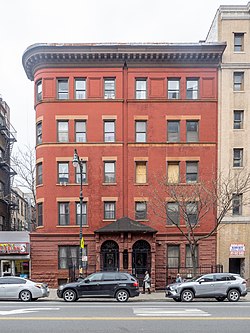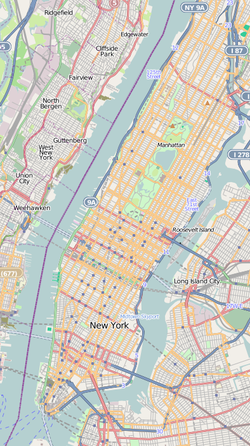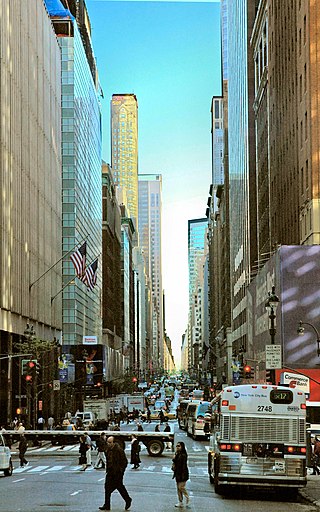
Madison Avenue is a north-south avenue in the borough of Manhattan in New York City, United States, that carries northbound one-way traffic. It runs from Madison Square to meet the southbound Harlem River Drive at 142nd Street, passing through Midtown, the Upper East Side, East Harlem, and Harlem. It is named after and arises from Madison Square, which is itself named after James Madison, the fourth President of the United States.
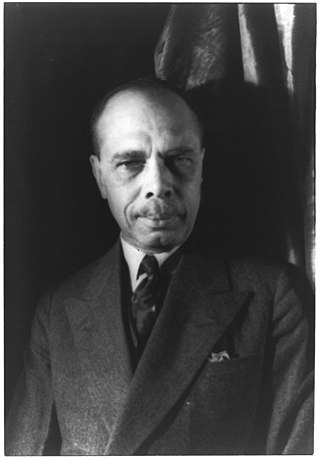
James Weldon Johnson was an American writer and civil rights activist. He was married to civil rights activist Grace Nail Johnson. Johnson was a leader of the National Association for the Advancement of Colored People (NAACP), where he started working in 1917. In 1920, he was chosen as executive secretary of the organization, effectively the operating officer. He served in that position from 1920 to 1930. Johnson established his reputation as a writer, and was known during the Harlem Renaissance for his poems, novel and anthologies collecting both poems and spirituals of Black culture. He wrote the lyrics for "Lift Every Voice and Sing", which later became known as the Black National Anthem, the music being written by his younger brother, composer J. Rosamond Johnson.

The Church of the Intercession is an Episcopal congregation located at 550 West 155th Street, at Broadway, on the border of the Harlem and Washington Heights neighborhoods of Manhattan, New York City, on the grounds of Trinity Church Cemetery. The congregation was founded in 1846, and the current sanctuary, built in 1912–1915, was designed by Bertram Grosvenor Goodhue in the Gothic Revival style. From 1906–1976, it was a chapel of Trinity Church.

The Schomburg Center for Research in Black Culture is a research library of the New York Public Library (NYPL) and an archive repository for information on people of African descent worldwide. Located at 515 Malcolm X Boulevard between West 135th and 136th Streets in the Harlem neighborhood of Manhattan, New York City, it has, almost from its inception, been an integral part of the Harlem community. It is named for Afro-Puerto Rican scholar Arturo Alfonso Schomburg.

The Chester A. Arthur Home was the residence of the 21st president of the United States, Chester A. Arthur (1829–1886), both before and after his four years in Washington, D.C., while serving as vice president and then as president. It is located at 123 Lexington Avenue, between 28th and 29th Streets in Rose Hill, Manhattan, New York City. Arthur spent most of his adult life living in the residence. While Vice President, Arthur retreated to the house after the July 2, 1881 shooting of President James Garfield. Arthur was in residence here when Garfield died on September 19, and took the presidential oath of office in the building. A commemorative bronze plaque was placed inside the building in 1964 by the Native New Yorkers Historical Society and New York Life Insurance, and the house was designated a National Historic Landmark on January 12, 1965.
Lillian Harris Dean was an African-American cook and entrepreneur who became a minor national celebrity in the 1920s for bringing the cuisine of Harlem, New York City, to national attention.
Mount Morris Park Historic District is a 16-block historic district in west central Harlem, Manhattan, New York City. It was designated by the New York City Landmarks Preservation Commission in 1971, and is part of the larger Mount Morris Park neighborhood. The boundaries are West 118th and West 124th Streets, Fifth Avenue, and Adam Clayton Powell Jr. Boulevard.

The Dyckman House, now the Dyckman Farmhouse Museum, is the oldest remaining farmhouse on Manhattan island, a vestige of New York City's rural past. The Dutch Colonial-style farmhouse was built by William Dyckman, c.1785, and was originally part of over 250 acres (100 ha) of farmland owned by the family. It is now located in a small park at the corner of Broadway and 204th Street in Inwood, Manhattan.

The Harlem YMCA is located at 180 West 135th Street between Lenox Avenue and Adam Clayton Powell Jr. Boulevard in the Harlem neighborhood of Manhattan, New York City. Built in 1931-32, the red-brown brick building with neo-Georgian details was designed by the Architectural Bureau of the National Council of the YMCA, with James C. Mackenzie Jr. as the architect in charge. It replaced the building from 1919 across the street. Inside the building is a mural by Aaron Douglas titled "Evolution of Negro Dance." The building was declared a National Historic Landmark in 1976, and was designated a New York City Landmark in 1998.

Florence Mills House is a house at 220 West 135th Street in Harlem, Manhattan, New York City. The house was originally believed to be the residence of Florence Mills, a leading African-American actress and entertainer during the 1920s. She lived at this address, or a similar address a few blocks away, during her most productive years from 1910 to 1927. The 220 West 135th Street building that existed in 1927 no longer stands and has been replaced. The site was designated a National Historic Landmark in 1976.

The Will Marion Cook House is a historic townhouse at 221 West 138th Street, in the part of Harlem known as Strivers' Row in Manhattan, New York City. It was the home of Will Marion Cook (1869-1944), a leading African-American musician and composer of the period, from 1918 until his death in 1944. Cook was a major influence on later musicians including Sidney Bechet, Duke Ellington, and Josephine Baker. It was declared a National Historic Landmark in 1976.

The New York Amsterdam News Building is a historic rowhouse at 2293 Seventh Avenue in the Harlem neighborhood of Manhattan, New York City. It is historically significant as the publishing home of the New York Amsterdam News between 1916 and 1938. During this period, the newspaper became one of the nation's most influential publications covering African-American issues. It was designated a National Historic Landmark in 1976. The Amsterdam News now publishes out of a building at 2340 Frederick Douglass Boulevard.

The Duke Ellington House is a historic residence at 935 St. Nicholas Avenue, in Manhattan, New York City. Apartment 4A in this apartment house was the home of Duke Ellington (1899–1974), the noted African American composer and jazz pianist, from 1939 through 1961. It was listed on the National Register of Historic Places as a National Historic Landmark in 1976, and became a New York City designated landmark in 2023.

The Matthew Henson Residence is a historic apartment residence at 246 West 150th Street in Manhattan, New York City. Apartment 3F in this building is where Matthew Henson (1866-1955), the African American polar explorer, lived from 1929 until his death. Henson was arguably the first man to reach the Geographic North Pole, a feat that is disputed in part by his own diary. His residence was named a National Historic Landmark in 1975.

James Addison Johnson was an American architect known for his design of various architectural landmarks in Buffalo, New York, and his use of decorative work that many consider a foreshadowing of art deco design.

St. Philip's Episcopal Church is a historic Episcopal church located at 204 West 134th Street, between Adam Clayton Powell Jr. Boulevard and Frederick Douglass Boulevard in the Harlem neighborhood of Manhattan, New York City. Its congregation was founded in 1809 by free African Americans worshiping at Trinity Church, Wall Street as the Free African Church of St. Philip. First located in the notorious Five Points neighborhood, it is the oldest black Episcopal parish in New York City. Historically, it was extremely influential both while located in lower Manhattan and as an institution in Harlem, and many of its members have been leaders in the black community. In 2020, it reported 188 members, 111 average attendance, and plate and pledge income of $224,827.

The Croton Aqueduct Gate House is located in Manhattanville, Manhattan, New York City, New York. The building was built in 1884 and was added to the National Register of Historic Places on September 22, 1983. After being decommissioned in 1984, the below-grade valve chambers were filled and the building sat empty for nearly two decades. Between 2004 and 2006, Ohlhausen DuBois Architects oversaw an adaptive reuse project converting the gate house into theater space for Harlem Stage/Aaron Davis Hall.
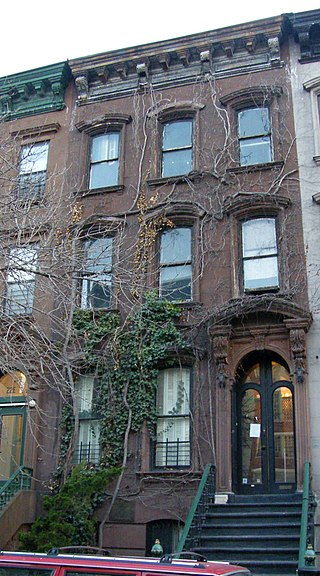
The Langston Hughes House is a historic home located in Harlem, Manhattan, New York City. It is an Italianate style dwelling built in 1869. It is a three-story-with-basement, rowhouse faced in brownstone and measuring 20 feet wide and 45 feet deep. Noted African American poet and author Langston Hughes (1902–1967) occupied the top floor as his workroom from 1947 to 1967. The building's owners were Hughes's adopted uncle and aunt, Emerson and Ethel Harper. In this house, Hughes wrote Montage of a Dream Deferred and I Wonder as I Wander.
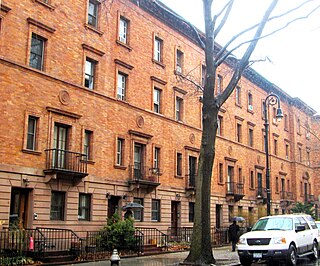
The St. Nicholas Historic District, known colloquially as "Striver's Row", is a historic district located on both sides of West 138th and West 139th Streets between Adam Clayton Powell Jr. Boulevard and Frederick Douglass Boulevard, in the Harlem neighborhood of Upper Manhattan, New York City. It is both a national and a New York City historic district, and consists of row houses and associated buildings designed by three architectural firms and built in 1891–93 by developer David H. King Jr. These are collectively recognized as gems of New York City architecture, and "an outstanding example of late 19th-century urban design":
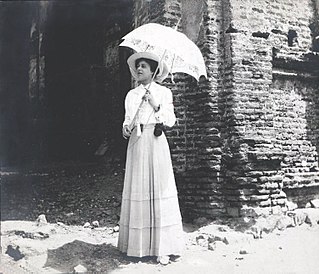
Grace Nail Johnson was an African-American civil rights activist and patron of the arts associated with the Harlem Renaissance, and wife of the writer and politician James Weldon Johnson. Johnson was the daughter of John Bennett Nail, a wealthy businessman and civil rights activist. She is known for her involvement with the National Association for the Advancement of Colored People (NAACP), the Heterodoxy Club, and many other African-American and feminist organizations. Johnson also supported and promoted African-American children's literature.
